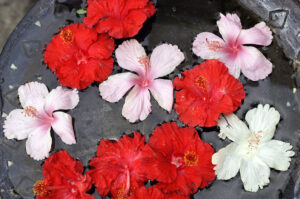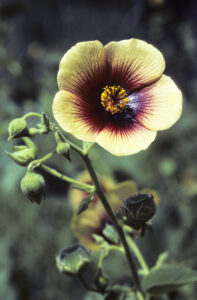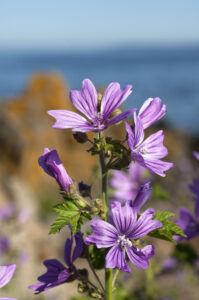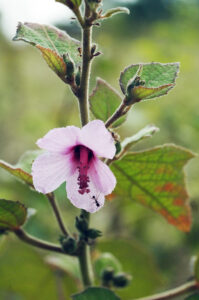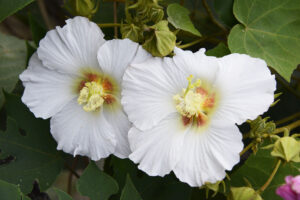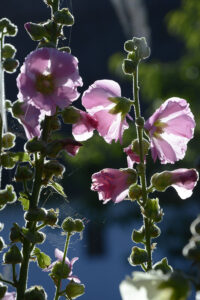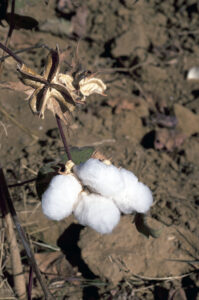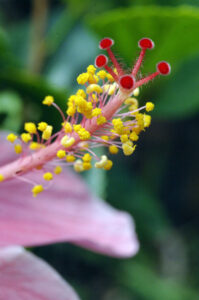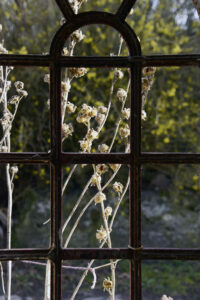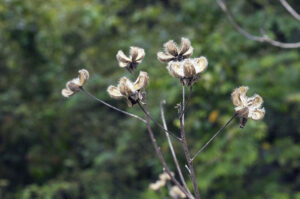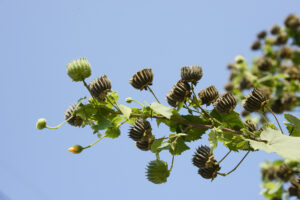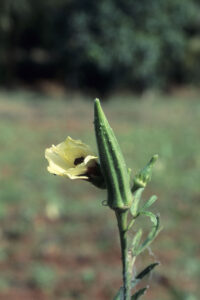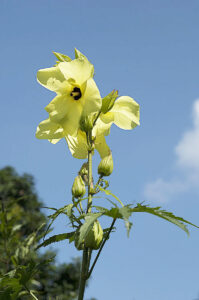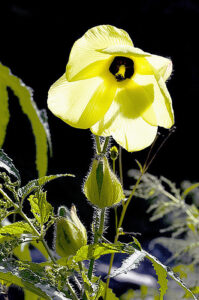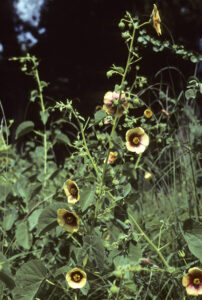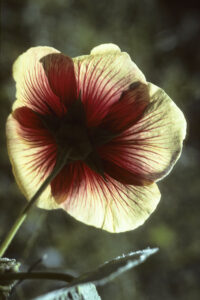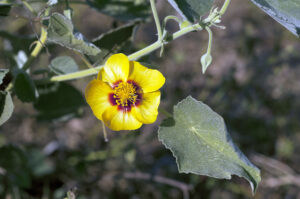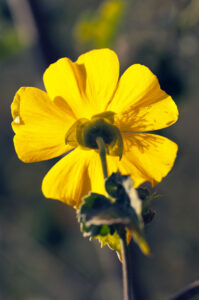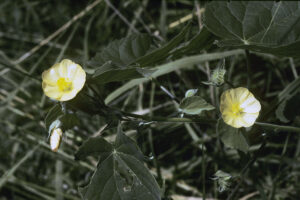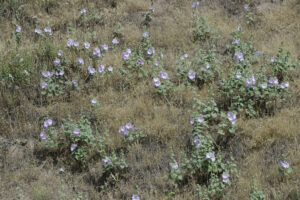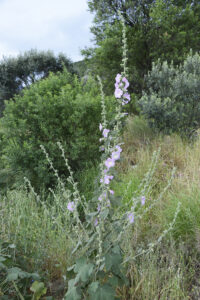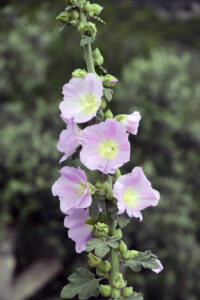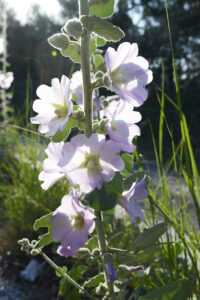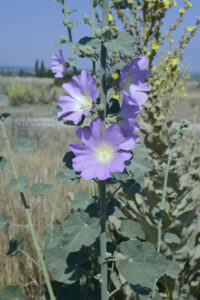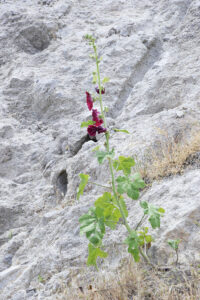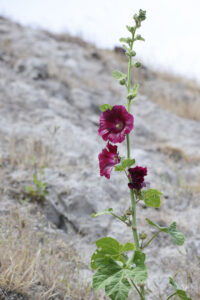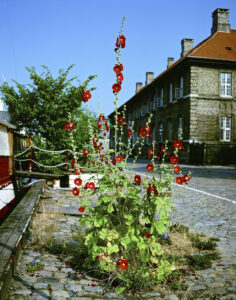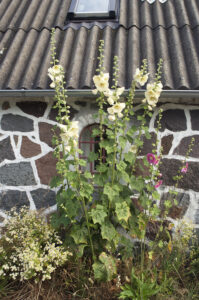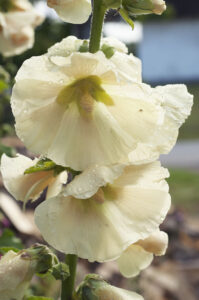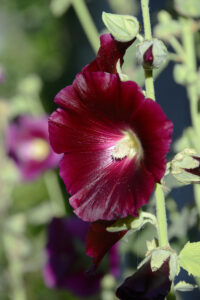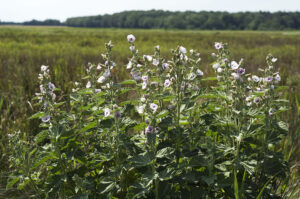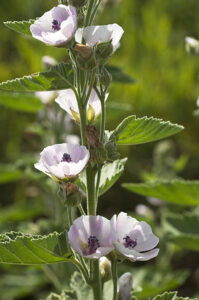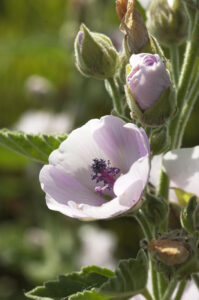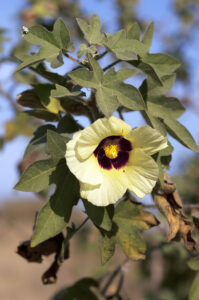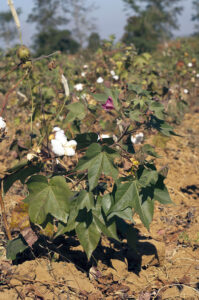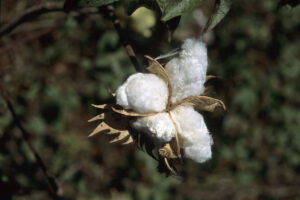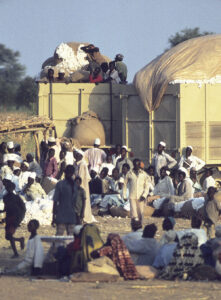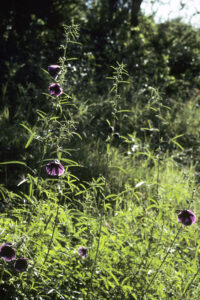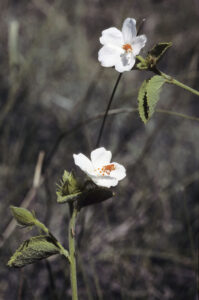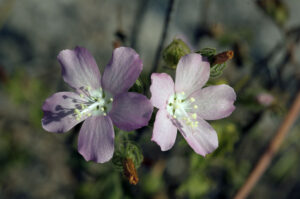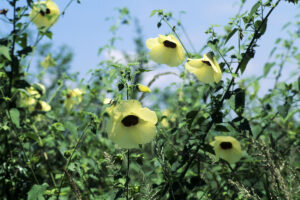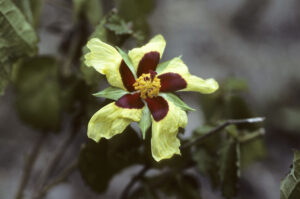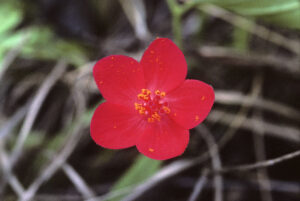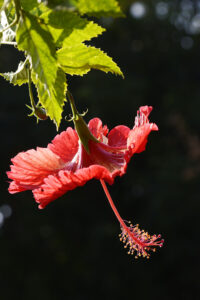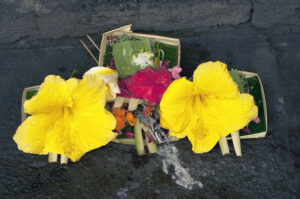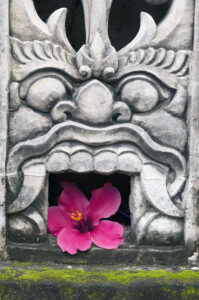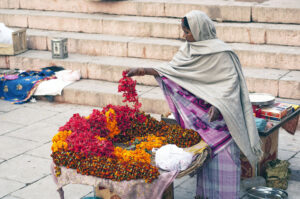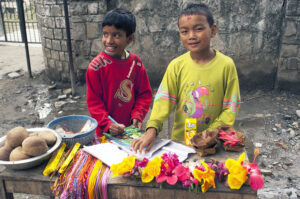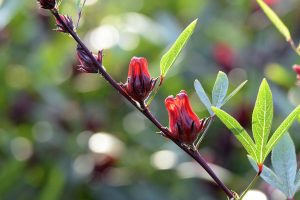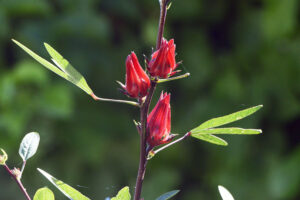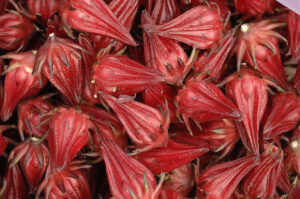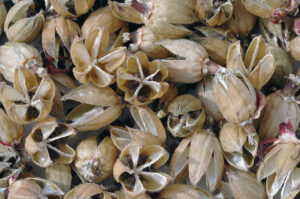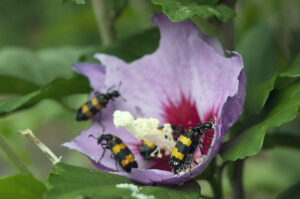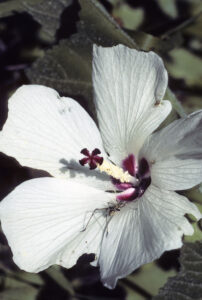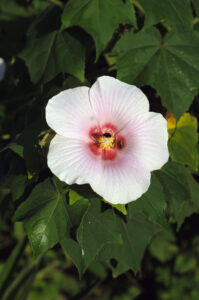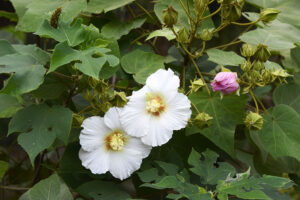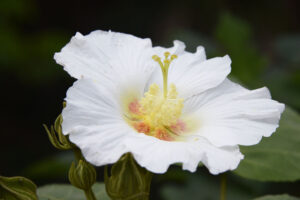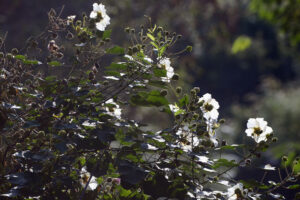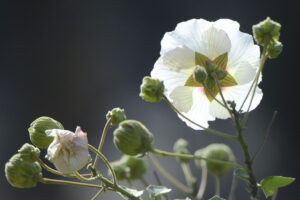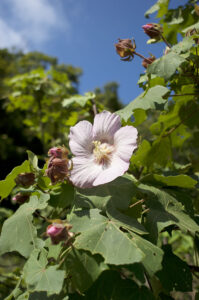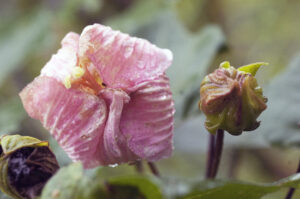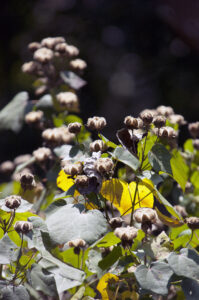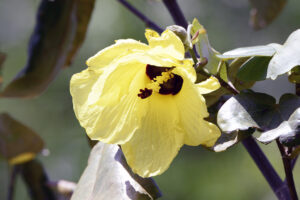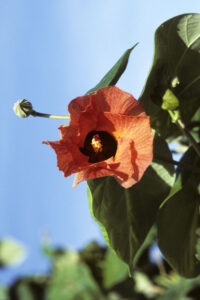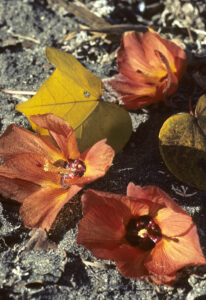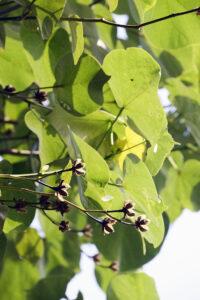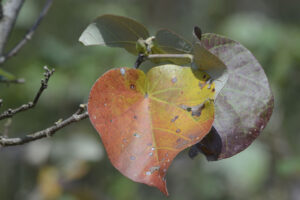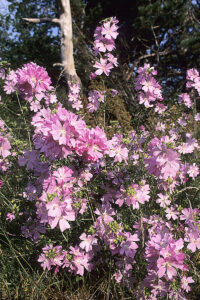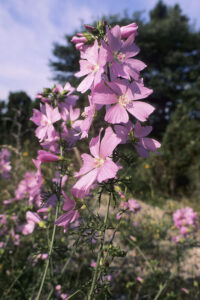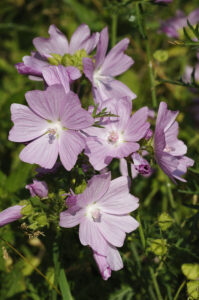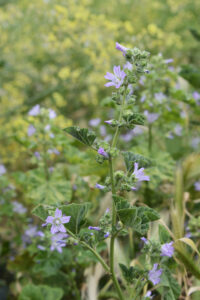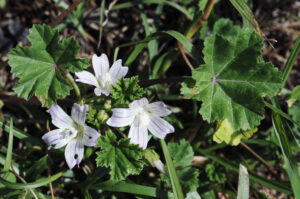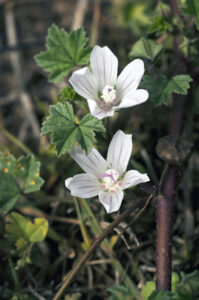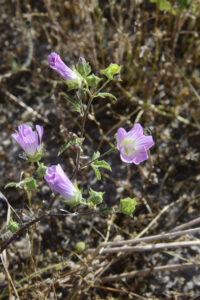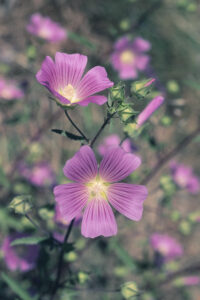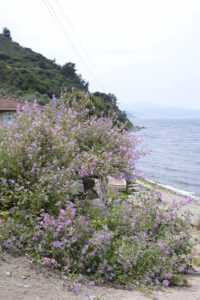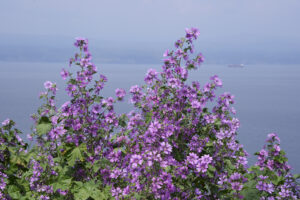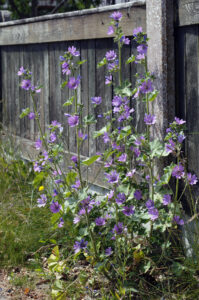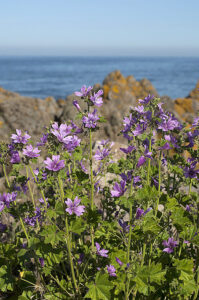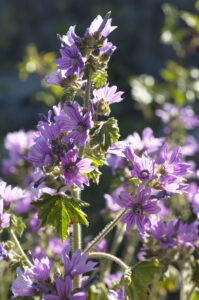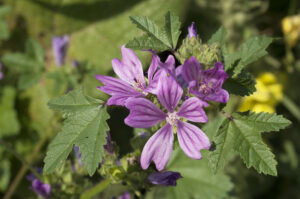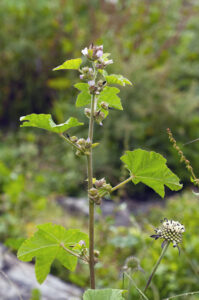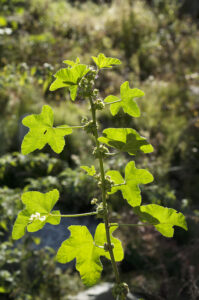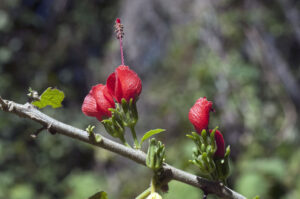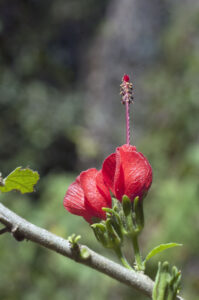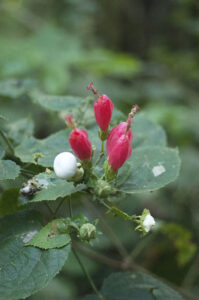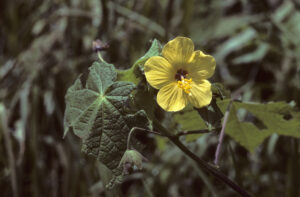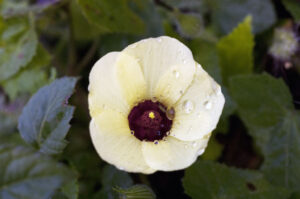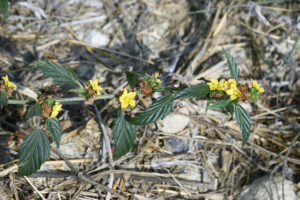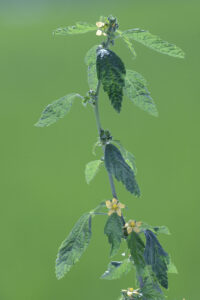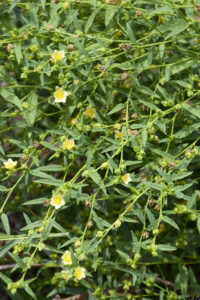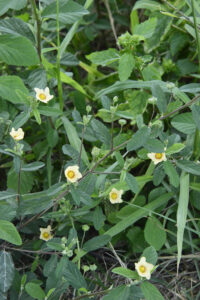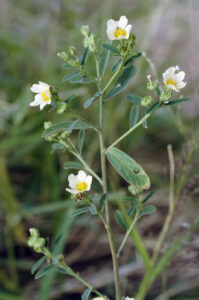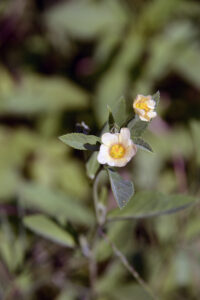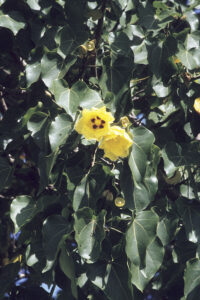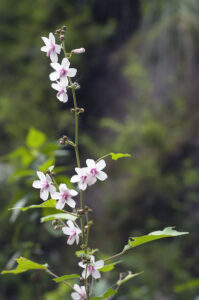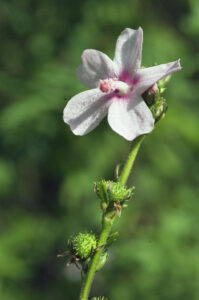Mallows and allies
Red, pink, and white flowers of rose mallow (Hibiscus rosa-sinensis) have been placed as an offering in a pond at the Water Temple, a Hindu temple in Ubud, Bali, Indonesia. (Photo copyright © by Kaj Halberg)
Abutilon hirtum, Samburu National Park, Kenya. (Photo copyright © by Kaj Halberg)
Common mallow (Malva sylvestris), growing among coastal rocks, Allinge, Bornholm, Denmark. (Photo copyright © by Kaj Halberg)
Urena lobata, Taichung, Taiwan. (Photo copyright © by Kaj Halberg)
Taiwan hibiscus (Hibiscus taiwanensis), Wufong, near Nantou, Taiwan. (Photo copyright © by Kaj Halberg)
Cultivated common hollyhock (Alcea rosea), Funen, Denmark. (Photo copyright © by Kaj Halberg)
I am the rose of Sharon, the lily of the valleys.
As the lily among thorns,
so is my love among the daughters.
Song of Solomon, 2:1-2.
Several plants have been proposed as the rose of Sharon, including Hibiscus syriacus (see below). The Plain of Sharon stretched along the Mediterranean Sea, from Mount Carmel in the north to the seaport of Jaffa (in the Bible called Joppa) in the south.
When I was a little bitty baby,
My mama would rock me in the cradle
In them old cotton fields back home.
Oh, when them cotton balls get rotten,
You can’t pick very much cotton
In them old cotton fields back home.
From Cotton Song, written by American blues musician and singer Huddie William Ledbetter (1888-1949), and first performed 1940.
“Oh, when them cotton balls get rotten…” – Cotton balls, Myanmar. (Photo copyright © by Kaj Halberg)
In later years, the mallow family (Malvaceae) has been greatly enlarged, as the former families Bombacaceae, Sterculiaceae, and Tiliaceae have been reduced to subfamilies of Malvaceae.
The former Malvaceae, sensu strictu, has been reduced to a subfamily, Malvoideae, which contains about 115 genera, characterized by having hibiscus- or hollyhock-like flowers. The filaments, with numerous stamens, form a tube around the styles, which have 5 lobed stigmas. There are nectaries at the base of the petals, which attract pollinators like bees and hover flies. The fruits are mostly capsules.
This page deals with Malvoideae. Well-known genera in this subfamily include Malva (mallow), Hibiscus, Alcea (hollyhock), Abelmoschus (okra), and Gossypium (cotton).
In case you come across any errors on this page, please let me know. You can use the address at the bottom of the page.
Stamens and stigmas of rose mallow (Hibiscus rosa-sinensis), Longdongwan Cape, north-eastern Taiwan. (Photo copyright © by Kaj Halberg)
Fruiting hollyhocks (Alcea rosea) outside a barn window, Funen, Denmark. (Photo copyright © by Kaj Halberg)
Fruiting Taiwan hibiscus (Hibiscus taiwanensis), Dasyueshan National Forest, Taiwan. (Photo copyright © by Kaj Halberg)
Fruiting Indian mallow (Abutilon indicum), Taichung, Taiwan. (Photo copyright © by Kaj Halberg)
Abelmoschus Okra and allies
A genus of about 12 species, native to tropical Africa, Asia, and northern Australia.
The generic name is derived from Arabic ḥabb al-misk (‘pills of musk’), referring to the scented seeds.
Abelmoschus esculentus Okra, ladies’ fingers
The place of origin of okra is disputed, but today the plant is cultivated in warmer regions around the world. It constitutes an important part of the cuisines of Asia, the Middle East, and the southern United States.
The specific name is derived from the Latin esca (‘food’) and ulentus (‘abounding in’), thus ‘fit for human consumption’. The English name ladies’ fingers refers to the fruits, which somewhat resemble the bony fingers of an elderly lady.
Okra flower and fruit, Mysore, Karnataka, India. (Photo copyright © by Kaj Halberg)
Market with okras (in front, right), cabbages, chili peppers, tomatos, and other vegetables, Valparai, Tamil Nadu, India. (Photo copyright © by Kaj Halberg)
Abelmoschus manihot Aibika
Aibika is an herb with a woody base, to 3 m tall, most parts bristly yellow-haired, stem often black-dotted. Leaves are long-stalked, to 30 cm across, deeply palmately lobed. Flowers large, to 13 cm across, pale yellow with a purple centre.
This species is indigenous from the Indian Subcontinent eastwards through Indochina to southern China, and thence southwards to the Philippines, Indonesia, and New Guinea. It is cultivated elsewhere as an ornamental under a variety of names, including sunset muskmallow, sunset hibiscus, and sweet hibiscus. It often escapes cultivation and is regarded as an invasive in several countries.
In some places, it is cultivated as a source of food. The leaves are eaten in several Pacific Islands. In Japan and Korea, paper is made from the plant.
In Nepal, juice from the root is applied to sprains, whereas a paste of the bark is applied to wounds. Juice of the flowers is used as a remedy for bronchitis and tooth ache. In traditional Chinese medicine, it is widely used to treat kidney problems.
Aibika is common in the lower valleys of the Himalaya, here photographed in the Marsyangdi Valley, Annapurna, Nepal. (Photos copyright © by Kaj Halberg)
Abutilon
A large genus, comprising about 200 species, distributed worldwide in the tropics and subtropics.
The generic name is Latin, referring to a kind of plant used to treat wounds, derived from Arabic ‘abūṭīlūn, from ‘abū (‘father’, or ‘source’) and ṭaylūn (‘toad’), a misreading of Syriac ‘arqūṭī’ūn, partly from Greek arkion, the name of burdock (Arctium), which was widely used as a medicinal plant.
At the beginning of this page, a picture shows fruits of Abutilon indicum.
Abutilon hirtum
This species grows to 2.5 m tall, stem woody below, stem, leaf-stalks, and flower-stalks sticky-hairy. It is found in open areas, including woodland, shrubberies, savannas, roadsides, and along fences, sometimes on termite mounds, from sea level to an elevation of about 1,800 m. It is distributed in drier regions of tropical Africa, Arabia, Iran, the Indian Subcontinent, China, and Indochina. It has also become naturalized in Central and South America.
The plant is harvested for local use as a source of fibres, medicine, and food. It is sometimes grown as an ornamental.
Abutilon hirtum, Samburu National Park, Kenya. (Photos copyright © by Kaj Halberg)
Abutilon hirtum, Bagan, Myanmar. (Photos copyright © by Kaj Halberg)
Abutilon mauritianum
A common species, distributed in Africa in dry areas south of the Sahara, from Ghana eastwards to Ethiopia, and thence southwards to Angola and Mozambique, and also in the southern part of the Arabian Peninsula.
It grows in open areas, including fallow fields, roadsides, open woodland, and shrubberies, from sea level up to about 2,300 m. It is collected for medicine and food, and sometimes cultivated as an ornamental.
Abutilon mauritianum, Samburu National Park, Kenya. (Photo copyright © by Kaj Halberg)
Alcea Hollyhocks
This genus contains more than 80 species, native from eastern Europe eastwards to Kazakhstan and Xinjiang, southwards to Egypt, Arabia, and Pakistan. Several species are cultivated elsewhere and have become naturalized in many places.
In classical Greek, the word alkea denotes a species in the mallow family, derived from alalkein (‘fend off’), alluding to its usage to cure wounds and eye problems.
When the common hollyhock (below) was imported to England, herbalist William Turner (c. 1509-1568), named it holihocke, from holi (‘holy’) and hoc, the Old English name for marsh-mallow (Althaea officinalis).
Alcea biennis Pale hollyhock, Turkish hollyhock
This plant, also known as A. pallida, grows to about 2 m tall, stem downy, leaves rather thick, simple or with 5-7 weak lobes, with rather stiff hairs above, bracts almost as long as the calyx, petals white, pink, or lilac, to 5 cm long, usually yellow towards the throat.
It is distributed from the Czech Republic and Austria eastwards to Ukraine, southwards to Greece and Turkey, growing in grasslands and fields, and along roads and banks, at elevations between 300 and 1,500 m. It has also been reported from a single location in eastern France, possibly an escape.
Pale hollyhock is very common in Turkey. This growth was photographed in the Boz Dağlari Mountains (1088 m), east of Manisa. (Photo copyright © by Kaj Halberg)
Pale hollyhock, Turgutlu, east of Manisa, Turkey. (Photos copyright © by Kaj Halberg)
Pale hollyhock, two colour forms, Pamukkale, Turkey. The yellow-flowered plant in the lower picture is a species of mullein (Verbascum). (Photos copyright © by Kaj Halberg)
Alcea rosea Common hollyhock
A stately plant, sometimes growing to 3 m tall. The origin of this beloved plant is not clear. It is possibly a hybrid between A. biennis (above) and A. setosa. According to Kew Gardens, it evolved in Turkey.
At a very early stage, it was imported to Europe, possibly before the 15th Century. Today, it is cultivated almost worldwide, coming in an abundance of flower colours.
Common hollyhock, escaped from cultivation, Karaburun Peninsula, near Izmir, Turkey. (Photos copyright © by Kaj Halberg)
Common hollyhock, escaped from cultivation, Copenhagen, Denmark. (Photo copyright © by Kaj Halberg)
Various flower colours of cultivated common hollyhocks, Funen, Denmark. In the uppermost picture, feverfew (Tanacetum parthenium) is also seen. (Photos copyright © by Kaj Halberg)
Althaea Marsh-mallows
A genus of 9 species, distributed from central and southern Europe eastwards to central Siberia, southwards to North Africa, Jordan, Iran, and Pakistan.
According to some sources, the generic name is derived from althaino (‘to heal’), alluding to the healing properties of common marsh-mallow (below).
However, Althaea is also the name of a queen in Greek mythology, the wife of Oeneus, king of Calydon. They had a number of sons, including Meleager, who, according to some sources, was the result of Althaea sleeping with the god Ares. Althaea and Meleager became the cause of each other’s deaths. When Meleager was born, it was predicted that he would only live until a cinder, burning in the family hearth, was consumed by fire. Althaea removed the cinder and concealed it.
One spring, when Meleager had grown up, Oeneus sacrificed the first fruits of the seasons to all the gods, but omitted Artemis by mistake. Enraged, she sent a huge boar to ruin the land of Calydon. Althaea’s brothers, Meleager, and the famous huntress Atalanta tried to kill the boar. Meleager succeeded, giving the hide to Atalanta, as he had fallen in love with her. Althaea’s brothers got very angry and took the skin from her, maintaining that it belonged to them by right of birth. Enraged, Meleager killed both of his uncles.
When Althaea learned what had happened, she retrieved the cinder and placed it back upon the fire, thus killing Meleager. Then she killed herself.
Althaea officinalis Common marsh-mallow
This species is native from the Baltic Sea southwards to south-eastern Europe, and thence eastwards across southern Siberia. It has become naturalized in other parts of Europe and in eastern United States.
In Ancient Egypt, the sap was extracted and mixed with nuts and honey, or the soft, spongy pith was boiled in sugar syrup and dried to produce a soft, chewy sweet. In the old days, in England and the United States, stem and root, which contains some sugar, were used in sweets, called marshmallows. Today’s marshmallows, however, have nothing to do with the plant. They are a mixture of whipped sugar, water, and gelatine, which is then moulded into small cylindrical pieces and coated with corn starch.
Since Ancient Egypt, an extract of the root has been used for cough. In Ancient Arabia, a poultice made from marshmallow was used for inflammation, and in Ancient Greece it was used for stings, wounds and ulcers. Traditionally, in Denmark, it was utilized for a number of ailments, including boils, dysentery, bladder stones, epilepsy, tuberculosis, tooth ache, colic, kidney pain, haemorrhoids, stomach ache, and whooping cough.
In today’s herbal medicine, common marshmallow is used for treatment of cough, colds, flu, bronchitis, diabetes, skin problems, ulcers, and urinary tract inflammation. All parts of the plant are rich in mucilage, which heals soreness and inflammation.
Originally, officinalis was derived from officina (‘workshop’, or ‘office’), and the suffix alis, which, together with a noun, forms an adjective, thus ‘made in a workshop’. However, in a botanical context, the word denotes plants species that were sold in pharmacies due to their medicinal properties.
The island of Lolland is one of the few places in Denmark, where common marsh-mallow is fairly common. (Photos copyright © by Kaj Halberg)
Gossypium Cotton
A large genus with about 50 species, native to tropical and subtropical regions around the globe. Cotton is harvested from a number of species.
The generic name is derived from Assyrian guzippu (‘cloth’), in Arabic corrupted to korsuf (‘cotton’). The common name originally came from Arabic quṭun, of uncertain origin. This became cotone in old Genoese Italian, coton in Old French, cotun in Anglo-Norman, and cotoun in Middle English.
Flowering cotton plant, Bagan, Myanmar. (Photo copyright © by Kaj Halberg)
Cotton plants with ripe fruits, Myanmar. (Photo copyright © by Kaj Halberg)
Close up of cotton balls, Karnataka, India. (Photo copyright © by Kaj Halberg)
Harvested cotton is loaded on trucks, Maroua, Cameroun. (Photo copyright © by Kaj Halberg)
Transportation of harvested cotton, Amritsar, Punjab, India. (Photo copyright © by Kaj Halberg)
Hibiscus
A huge genus with more than 450 species of herbs, shrubs, or small trees, found almost all over the globe, excluding colder regions.
The generic name is derived from the Greek ibiskos, a name given to Althaea officinalis (above) by Greek physician, pharmacologist, and botanist Pedanius Dioscorides (c. 40-90 A.D.), author of De Materia Medica, a 5-volume encyclopedia dealing with herbal medicine.
Hibiscus aponeurus
This shrubby herb, to about 1 m tall, grows in grasslands and shrubberies, from Sudan and Ethiopia southwards through Zaire and eastern Africa to northern Mozambique. It is easily identified by the small, bright red flowers, to 2 cm across, with spreading petals. The leaves are ovate or elliptic, to 4 cm across, often 3-lobed, downy, margin toothed.
Hibiscus aponeurus, Serengeti National Park (top) and Ngorongoro Crater, both in Tanzania. (Photos copyright © by Kaj Halberg)
Hibiscus cannabinus
The stem is to 3 m tall, with a woody base, leaves very variable, to 15 cm long, the lower ones often with 3-7 lobes, upper ones narrow, often lanceolate. The flowers are to 15 cm across, white, yellow, or purple, always with a dark purple centre.
The native range is believed to be Africa south of the Sahara, and the south-western part of the Arabian Peninsula. It is known to have been grown in Egypt more than 3,000 years ago. The leaves were used for food, stems for fuel, stem fibres for bags, rope, and sails. At an early stage, it was also introduced to many parts of Asia and to the United States, grown as a source of fibre, mainly to make rope.
Cultivated plants are known as kenaf, derived from Persian kanaf (‘hemp’). The specific name is a derivation of Ancient Greek kannabinos, from kannabis (‘hemp’) and inos, a suffix added to nouns to form an adjective, thus ‘hemp-like’, alluding to the stem fibres.
Hibiscus cannabinus, Meru National Park, Kenya. (Photos copyright © by Kaj Halberg)
Hibiscus flavifolius
A shrubby plant, to 2 m tall, with snow-white petals and very conspicuous orange stamens. Leaves are hairy, with a toothed margin. Their yellowish-green colour gave rise to the specific name, from the Latin flavus (‘yellow’, ‘golden’) and folium (‘leaf’).
This species is restricted to eastern Africa, found in Ethiopia, Somalia, Uganda, Kenya, and Tanzania. It is abundant in many places, as grazing animals avoid it.
Hibiscus flavifolius, Lake Nakuru, Kenya. (Photo copyright © by Kaj Halberg)
Hibiscus micranthus
The plant in the picture below has tentatively been identified as this species.
Hibiscus micranthus (?), Bagan, Myanmar. (Photo copyright © by Kaj Halberg)
Hibiscus ovalifolius
The native range of this plant is from Ethiopia and Eritrea southwards through Zaire and eastern Africa to Namibia, Botswana, and South Africa, in the southern Arabian Peninsula, the Indian Subcontinent, and Indochina. It grows in woodlands, shrubberies, and grasslands.
It is a shrubby herb to 3 m tall, but often much lower, leaves long-stalked, variable, often rounded in outline, usually 3-5-lobed, to 12 cm across, base heart-shaped, margin toothed. Flowers solitary, axillary, pale yellow, usually with a purple or dark red centre.
The specific name is derived from the Latin ovalis (‘ovate’) and folium (‘leaf’).
Hibiscus ovalifolius, Birchenough Bridge, Zimbabwe (top) and Serengeti National Park, Tanzania. (Photos copyright © by Kaj Halberg)
Hibiscus rhodanthus
A most remarkable species. The bright red flowers, to 4 cm across, appear directly from the rootstock, when a fire has removed vegetation from the ground. Later, during the rainy season, the plant grows taller, sometimes to 1 m, developing leaves.
It is found from Zaire and Uganda southwards to Angola, Zimbabwe, and Mozambique, growing in woodlands.
Hibiscus rhodanthus, Kasanka National Park, Zambia. (Photo copyright © by Kaj Halberg)
Hibiscus rosa-sinensis Rose mallow, Chinese hibiscus, Hawaiian hibiscus
Despite two of its popular names, the place of origin of this beloved plant is unknown. Today, it is widely cultivated in tropical and subtropical areas as an ornamental. It is also much utilized as an offering at Buddhist and Hindu shrines. The flowers are mostly bright red, but pink, yellow, and white forms also occur.
The specific name is Latin, meaning ‘rose of China’. However, it is not even distantly related to roses.
Rose mallow, Taichung, Taiwan. (Photo copyright © by Kaj Halberg)
Rose mallow, Longdongwan Cape, north-eastern Taiwan. (Photo copyright © by Kaj Halberg)
Yellow and red rose mallow flowers, marigolds (Tagetes), rice, and incense sticks have been placed as an offering at a Hindu temple, Ubud, Bali, Indonesia. (Photo copyright © by Kaj Halberg)
This sculpture, depicting a guardian outside a Hindu temple in Ubud, has been adorned with a rose mallow. (Photo copyright © by Kaj Halberg)
This woman is selling garlands, called malla, made from rose mallows and marigolds, on the shore of the sacred Ganges River, Varanasi, India. (Photo copyright © by Kaj Halberg)
These boys are doing homework while selling offerings outside a Hindu temple in the village of Galeshwor, Kali Gandaki Valley, Annapurna, Nepal: rose mallows and Canna flowers, coconuts, and colourful ribbons. (Photo copyright © by Kaj Halberg)
Hibiscus sabdariffa Roselle
The name roselle is from the French, a diminutive of rose, referring to the red calyx, which, with a bit of imagination, resembles a small rose. The plant is known by a huge number of other names, including Jamaica sorrel, Indian sorrel, Guinea sorrel, Queensland jelly plant, jelly okra, Florida cranberry. The word sorrel is an old expression for a special type of red, found in the seeds of some Rumex species, in the roselle calyx, and in other plants.
Some authorities propose that this species is most likely a native of West Africa, but it has been cultivated in Asia and elsewhere since about the 1400s. Today, it is grown worldwide in tropical and subtropical areas, the largest producers being China and Thailand.
In Senegal and other African countries, and in various Asian countries, the green leaves are eaten as a spicy vegetable. In Nepal, the calyx is eaten raw or pickled. From the calyx, jam and a red drink, called karkade, are produced. In Europe and North America, the calyx is used for food colouring. Bast is produced from the stem fibres.
Traditionally, roselle has been used as a diuretic and as a mild laxative. In Brazil, the root is used as a stomachic, and also as an emollient. The Naga people of north-eastern India drink an extract of the root for constipation and stomach ache, and as an emollient and carminative. The red calyx contains antocyanins, and research indicates that these substances can prevent rheumatism, diabetes, and colon cancer. Antocyanins are excellent anti-oxidants, which can subdue infections. The seeds are also a good source of anti-oxidants.
The pictures below are all from Taiwan, where roselle is commonly cultivated.
Roselle has white or pink flowers with a red or purple centre. (Photos copyright © by Kaj Halberg)
The bright red calyx of roselle contains antocyanins. (Photos copyright © by Kaj Halberg)
Dried roselle fruits. (Photo copyright © by Kaj Halberg)
Hibiscus syriacus Syrian rose mallow, Rose of Sharon
A large shrub, to 4 m tall, native to southern China, but cultivated in Korea since time immemorial. It was also introduced to other Asian countries at an early stage, and brought to Europe as early as the 16th Century. Today, it is cultivated in most parts of the world. Flowers purplish-violet, pink, or white, told from the similar common rose mallow (above) by 5 reddish-purple spots in the throat.
The specific name means ‘from Syria’. Presumably, Swedish naturalist Carl Linnaeus (1707-1778), who named the plant in 1753, received specimens from Syria, so he must have thought that it was native to that area.
The name Rose of Sharon stems from the belief that this plant was the famous Rose of Sharon in the Biblical Song of Solomon (see top of this page).
Beetles, eating petals of Syrian rose mallow, Kathmandu Valley, Nepal. (Photo copyright © by Kaj Halberg)
White form of Syrian rose mallow, Banawe, Luzon, Philippines. (Photo copyright © by Kaj Halberg)
This Malvaceae, photographed in Tortuguero National Park, Limón, Costa Rica, is possibly a variety of Hibiscus syriacus. (Photo copyright © by Kaj Halberg)
Hibiscus taiwanensis Taiwan hibiscus, Taiwan cotton rose
As its name implies, this shrub is endemic to Taiwan, where it is very common from the lowlands to medium elevations in the mountains. It is widely cultivated. It sometimes grows to 5 m tall, but is mostly much lower. The leaves are broadly ovate to circular in outline, to 10 cm across, with pointed lobes. The flowers, white or pinkish, are edible. Formerly, the root was used in folk medicine.
Taiwan hibiscus, Wufong, near Nantou. In the centre picture, leaves of paper mulberry (Broussonetia papyrifera) is seen to the left. This tree is presented on the page Nature: Invasive species. (Photos copyright © by Kaj Halberg)
Taiwan hibiscus, Tunghai University Park, Taichung. (Photos copyright © by Kaj Halberg)
Pink flower of Taiwan hibiscus, photographed around noon, Lake Nanren Hu, Kenting National Park. (Photo copyright © by Kaj Halberg)
This pink flower of Taiwan hibiscus is curling up, photographed late in the afternoon, near Jianshi, Hsinchu. (Photo copyright © by Kaj Halberg)
Fruiting Taiwan hibiscus, Dasyueshan National Forest. (Photo copyright © by Kaj Halberg)
Hibiscus tiliaceus Coast hibiscus, sea hibiscus
Also known as Talipariti tiliaceum, this small tree, to 10 m tall, is common along tropical and subtropical coasts in Africa, South and Southeast Asia, eastern and northern Australia, the Pacific, Mexico, Central America, and northern South America.
It mainly grows on beaches, in river deltas, and in mangrove swamps, but may also be found inland up to elevations of about 800 m, provided there is ample rainfall. When withering, the flowers change colour from bright yellow to orange.
This species is very similar to Thespesia populnea (below), but may at once be identified by the dark purple stigmas (versus yellow in Thespesia). Also, the throat of the flower is a solid dark purple (versus 5 purple spots in Thespesia).
The specific name refers to the heart-shaped leaves, which resemble those of certain species of linden (Tilia).
Coast hibiscus, Taichung, Taiwan. (Photos copyright © by Kaj Halberg)
When withering, the flowers of coast hibiscus change colour from bright yellow to orange. – Buyuni Bay, Tanzania (top), and Gili Air, Lombok, Indonesia. (Photos copyright © by Kaj Halberg)
Fruiting coast hibiscus, Xitun Botanical Garden, Taichung, Taiwan. (Photo copyright © by Kaj Halberg)
When ageing, the leaves of coast hibiscus sometimes turn reddish. – Taichung. (Photo copyright © by Kaj Halberg)
Hibiscus vitifolius
This shrubby herb, growing to 2.5 m tall, is usually densely velvet-hairy on all parts. The leaves, to 6 cm across, resemble leaves of grapevine (Vitis vinifera), which is reflected in the specific name, derived from the Latin vitis (‘grapevine’) and folium (‘leaf’). The flowers, occurring singly in the leaf axils, are stalked, to 6 cm across, petals various shades of yellow with a purple centre.
It is widely distributed in sub-Saharan Africa, on the Arabian Peninsula, in South and Southeast Asia, Indonesia, New Guinea, and Australia.
Hibiscus vitifolius, Lake Bogoria, Kenya. (Photo copyright © by Kaj Halberg)
Lavatera Tree-mallows
Members of this genus have been transferred to genus Malva (below).
Malva Mallows
A genus with about 52 species, widespread in temperate, subtropical, and tropical regions of Eurasia and Africa.
The generic name is the classical Latin word for mallow, adapted from the Greek word for the same plants, malakhe, originally from Hebrew malluah, a plant used as salad. The common name is a corruption of Old English mealwe, an adaptation of the Latin name. The word for the colour mauve was adapted from the French name of these plants.
Malva moschata Musk mallow
A very pretty plant, growing to about 70 cm tall, with bright pink flowers, gathered in clusters in the leaf axils, each flower to 5 cm in diameter, petals notched. The flowers emit a distinctive musky odour. The leaves are alternate, to 8 cm across, palmately lobed with 5-7 lobes. They are used in salads, and the seeds are also edible.
It is native to central and southern Europe, from Spain and the British Isles eastwards to Belarus, Ukraine, and Turkey, but has been introduced as an ornamental elsewhere and has become naturalized in many places, including Scandinavia, New Zealand, and North America. It grows in dry areas, from sea level up an elevation of about 1,500 m.
Musk mallow, naturalized near Lummelunda, Gotland, Sweden. (Photos copyright © by Kaj Halberg)
Naturalized musk mallow, Zealand, Denmark. (Photos copyright © by Kaj Halberg)
Malva neglecta Dwarf mallow
Stem branched, to 90 cm long, often prostrate, downy, leaves alternate, long-stalked, to 7 cm across, rounded or kidney-shaped in outline, with 5 or more shallow lobes, flowers 1-3 on short stalks from the leaf axils, to 3 cm across, petals more or less notched, pale violet or white, with darker violet, longitudinal streaks.
This plant grows in open areas on disturbed ground. It is indigenous to the major part of Europe eastwards to the Ural Mountains, and from North Africa across the Arabian Peninsula to Kazakhstan and the western Himalaya.
Leaves and stalks can be cooked as a vegetable, young seeds may be eaten raw, and mature seeds can be cooked together with grains. The leaves are chewed for sore throat.
The specific name means ‘being ignored’. What it refers to is not clear.
Dwarf mallow, Istanbul, Turkey. (Photo copyright © by Kaj Halberg)
Dwarf mallow, Solang Nallah, Manali, Himachal Pradesh, India. (Photo copyright © by Kaj Halberg)
Dwarf mallow, near Roncal, Navarra, Spain. (Photo copyright © by Kaj Halberg)
Malva punctata Annual tree-mallow, spotted-stalked tree-mallow
This beautiful plant, formerly known as Lavatera punctata, grows to about 90 cm tall, stem erect, spotted, downy, lower leaves rounded or kidney-shaped in outline, 5-lobed, upper ones 3-lobed, the central lobe much larger than the lateral ones. Flowers are single, axillary, petals broadly triangular, notched, to 3 cm long, pink with purple veins.
It grows in shrubberies and open areas, including fallow fields, and along hedgerows and roads, from France and Algeria eastwards to the Caucasus, Iran, and Turkmenistan.
The specific name is Latin, meaning ‘dotted’, alluding to the spots on the stem.
Annual tree-mallow, Hierapolis, Turkey. (Photos copyright © by Kaj Halberg)
Malva sylvestris Common mallow
This species is native to temperate regions of Asia, Europe, and North Africa, but has been introduced elsewhere as an ornamental. It has become naturalized in many countries, including Australia, the United States, Canada, and Mexico.
It grows in open areas, including fallow fields, along hedges, and on the inner part of beaches. Stem to 1 m long, erect or ascending, leaves roundish, toothed, with 5-7 lobes, flowers in axillary clusters, petals pale violet or bright pinkish-purple with darker veins.
Several places around the Mediterranean, the leaves are steamed with garlic and tomatoes, eaten as an appetizer or a salad. In Egypt, the leaves are made into a stew-like vegetable dish, known as khobeiza. The leaves were also eaten as a vegetable in Europe in the 19th Century. The flowers were spread on doorways and woven into garlands for celebrating May Day.
In traditional medicine, the seeds were taken internally in tea to relieve irritation or inflammation of the mucous membranes, and the leaves were used in a poultices to soften the skin. A yellow dye can be obtained from the plant.
The specific name is Latin, meaning ‘growing in woods’ – not an appropriate name, as it grows in open areas.
Common mallow, near Mudanya, Marmara Sea, Turkey. (Photos copyright © by Kaj Halberg)
Common mallow, growing at a wooden fence, Jutland, Denmark. (Photo copyright © by Kaj Halberg)
Common mallow, growing among coastal rocks, Allinge, Bornholm, Denmark. (Photo copyright © by Kaj Halberg)
Common mallow, Christiansø, Bornholm, Denmark. (Photo copyright © by Kaj Halberg)
Common mallow as a garden weed, Funen, Denmark. (Photo copyright © by Kaj Halberg)
Malva unguiculata Bryony-leaved tree-mallow
Previously named Lavatera bryoniifolia, this impressive shrub grows to 3.5 m tall, stem hairy, leaves toothed, lower ones with 3-5 lobes, upper ones spear-shaped, mid-lobe longer than the lateral ones. The flowers are solitary or two together in leaf axils, pinkish-violet, petals to 3 cm long.
It is distributed around the eastern Mediterranean, from Sicily and Libya eastwards to Turkey and Jordan, growing on rocks and in other dry open areas.
The specific name is Latin, literally meaning ‘having a claw’, but in botanical context meaning ‘with a narrow base’, in this species alluding to the petals. The former specific name means ‘with leaves like bryony’ (Bryonia), climbing plants of the cucumber family (Cucurbitaceae).
Bryony-leaved tree-mallow, Lassithi Plain, Crete. (Photo copyright © by Kaj Halberg)
Malva verticillata Whorled mallow, Chinese mallow
The stem of this herb is hairy, to 1.5 m, sometimes 2 m tall. It may readily be identified by its very long leaf-stalks, to 24 cm, leaves to 25 cm across, with 3-7 rounded or triangular, toothed lobes. Flowers very small, 2 or more in whorls in the leaf axils, corolla pinkish-white or mauve.
It grows in open, disturbed areas, such as fallow fields and along trails. It is native to central and southern Asia, the Arabian Peninsula, and north-eastern Africa, but is widely cultivated and has become naturalized in most other temperate and subtropical parts of the globe. In Central Asia, it is found up to elevations of about 3,500 m.
The plant is used for fodder, and in folk medicine, and the leaves are eaten as salad or cooked as a vegetable.
The specific name is derived from the Latin verticillus (‘in a whorl’), alluding to the stalkless axillary flower clusters.
Whorled mallow, Thangshyap, Langtang Valley, central Nepal. The plant in the lower right corner is a species of teasel, Dipsacus inermis. (Photo copyright © by Kaj Halberg)
Fruiting whorled mallow, Bagarchap, Marsyangdi Valley, Annapurna, Nepal. (Photo copyright © by Kaj Halberg)
Malvaviscus
A genus with about 11 species, found from Louisiana and Texas southwards through Mexico and Central America to northern South America, southwards to Bolivia and northern Brazil.
These plants are closely related to members of Hibiscus (above), but the style has 10, not 5, stigmas, and the fruit is initially fleshy, red or white, later dry and 5-parted. Locally, the fruit is used to make jelly or syrup, and tea is made from both flowers and fruits.
The tubular flowers never open fully, an adaptation to attract butterflies and hummingbirds, which pollinate the flowers.
The generic name is derived from the Latin malva (‘mallow’) and viscus (‘sticky’), alluding to the sticky sap, produced by some members of the genus.
Malvaviscus arboreus
A shrub or small tree, growing to 8 m tall, leaves very variable, velvety-hairy, elliptic, ovate, or broadly ovate, base heart-shaped, margin roughly toothed, sometimes 3-lobed, to 15 cm long and 10 cm wide, flowers bright red, to 3.5 cm long, occurring singly in leaf axils.
It is native from Louisiana and Texas southwards through Mexico and Central America to northern South America, eastwards to Venezuela and Trinidad, southwards to Peru. It grows in rather dry forests.
It is widely cultivated under several names, including wax mallow and Turk’s-cap.
The specific name is Latin, meaning ‘tree-like’.
Malvaviscus arboreus, Palo Verde National Park, Guanacaste, Costa Rica. (Photos copyright © by Kaj Halberg)
Malvaviscus concinnus
This plant is very similar to the previous species, but its leaves are smooth, and the fruit is white, as opposed to red. It also grows in much wetter areas.
It is native from Costa Rica eastwards to Venezuela, and thence southwards to Bolivia and northern Brazil.
The specific name is Latin, meaning ‘pretty’ or ‘pleasing’.
Flowers and fruit of Malvaviscus concinnus, Corcovado National Park, Peninsula de Osa, Costa Rica. (Photo copyright © by Kaj Halberg)
Pavonia
A huge genus with about 290 species, distributed in tropical and subtropical regions around the world.
The generic name honours Spanish botanist José Antonio Pavón y Jiménez (1754-1840), whom King Carlos III of Spain (1716-1788), between 1777 and 1788, sent on 3 botanical expeditions to Peru and Chile, together with botanist Hipólito Ruiz López (1754-1816). These two botanists named altogether about 150 new genera and 500 new species.
Pavonia burchellii
A shrubby herb, to 1 m tall, flower colour very variable, yellow, orange, or white, sometimes with a reddish or purple centre. Leaves angled or shallowly 3-5 lobed, to 5 cm long and broad, base often heart-shaped. It grows in woodlands and shrubberies, often on sandy or rocky soils, sometimes on termite mounds.
This plant is distributed in eastern and southern Africa, from Chad and Egypt southwards to South Africa, and also in the Arabian Peninsula, found up to elevations of about 1,700 m.
The specific name commemorates English explorer and botanist William John Burchell (1781-1863) who was initially trader, schoolmaster, and botanist on the island of St. Helena 1805-1810. He then travelled for 5 years in southern Africa, collecting over 50,000 specimens of plants and insects. His journeys were related in a two-volume work, Travels in the Interior of Southern Africa (1822-1824).
Pavonia burchellii, Gibb’s Farm, near Ngorongoro, Tanzania. (Photo copyright © by Kaj Halberg)
Pavonia cancellata
The native range of this shrubby herb is from Nicaragua southwards to Bolivia, Paraguay, and southern Brazil, with an isolated population in the Veracruz area of Mexico.
The stem is trailing, to 2 m long, densely bristly-hairy, leaves to 4 cm long, broadly heart-shaped or triangular, often assymmetric, sometimes 3-lobed, margin strongly toothed, flowers yellow with a dark purple or reddish-purple throat, contrasting with the yellow stigmas.
The specific name is Latin, meaning ‘latticed’, presumably alluding to the veins on the leaves.
Flower of Pavonia cancellata with rain drops, Rincon de la Vieja National Park, Cordillera de Guanacaste, Costa Rica. (Photo copyright © by Kaj Halberg)
Sida
A huge genus with about 250 species, distributed in tropical and subtropical regions around the globe. Many species are regarded as unwanted weeds. They are avoided by grazing animals and tend to become invasive in pastures.
It is a bit of a mystery, why Swedish naturalist Carl Linnaeus (1707-1778) named the genus Sida. The Greek word side refers to the pomegranate tree (Pumila granatum), and the connection is hard to see.
Sida acuta Common sida
Today this plant, believed to have originated in Central America, is common in tropical and subtropical areas around the world, growing in open areas, including pastures, fallow fields, waste plots, and along roads. In Australia, it is considered an invasive weed.
It is a small shrub, erect or ascending, to 90 cm long, leaves variable, linear, lanceolate, or oblong, rarely ovate, smooth, to 9 cm long, with toothed margin. The flowers are axillary, single or few together, star-shaped, pale yellow, sometimes with a darker yellow centre, to 1 cm across.
Common sida, Taichung, Taiwan. The green background in the lower picture is a rice field. (Photos copyright © by Kaj Halberg)
Sida rhombifolia Arrow-leaved sida
Stem erect or ascending, branched, to 1.2 m tall, woody below. Leaves alternate, variable, diamond-shaped, arrow-shaped, oblong, or ovate, to 8 cm long, entire near the base, toothed on upper two thirds. Flowers long-stalked from near leaf axils, petals pale yellow, orange, apricot, or white, often with a reddish, purplish, or dark yellow centre, to 1.2 cm long.
This species is native to sub-Saharan Africa, southern Arabia, the Indian Subcontinent, Indochina, southern China, Taiwan, Japan, and the Philippines. It grows in disturbed places, including fallow fields, roadsides, and vacant plots. In Ayurvedic medicine, where it is known as kurunthotti, it is taken as a tonic, and to improve your immune system.
Arrow-leaved sida, Taichung, Taiwan. (Photos copyright © by Kaj Halberg)
Sidalcea Checker-mallow, checkerbloom
This genus, containing about 25 species, is native to central and western North America. The generic name is composed of the generic names Sida and Alcea, alluding to the resemblance of checker-mallows to members of these two genera.
An unidentified species of checker-mallow, North Umpqua River, Oregon. (Photo copyright © by Kaj Halberg)
Thespesia
This genus contains about 13 species, widely distributed in tropical and subtropical areas.
The generic name is derived from the Greek thespios (‘holy’ or ‘endowed with taboo’). Swedish naturalist Daniel Carlsson Solander (1733-1782) participated in Captain James Cook’s first great voyage on board the Endeavor (1768-1771). On Tahiti, he encountered Thespesia populnea (below), which was endowed with taboo by the locals.
Thespesia populnea
Growing to 20 m tall, this tree is partial to sandy or rocky beaches, and to the landward side of mangroves. It is very similar to coast hibiscus (Hibiscus tiliaceus, above), but may at once be identified by the yellow stigmas (versus dark purple in coast hibiscus). Also, the throat of the flower has 5 purple spots (versus a solid dark purple throat in coast hibiscus).
The specific name refers to the heart-shaped leaves, which resemble those of certain species of poplar (Populus).
Thespesia populnea, Bundala, Hambantota, Sri Lanka. (Photo copyright © by Kaj Halberg)
Urena
A genus of 7 species, widely distributed in the tropics and subtropics. The generic name is from Malayalam uren or uram, the local name of Urena lobata.
Urena lobata
An erect herb with a woody base, to 2.5 m tall, branched, densely woolly-hairy. The stalked leaves are ovate or rounded, to 8 cm across, with 3 toothed lobes. The small flowers are pink, solitary or 2-3 together in leaf axils, petals to 1.5 cm long, obovate.
This is a common and widespread species, pan-tropical, the native area is unknown. It grows in shrubberies, on open slopes, and along trails.
In the Himalaya, this plant has many uses. Rope and sacks are made from the stem fibres, and tannin is obtained from stem and leaves. Medicinally, juice of the root is used for dysentery and diarrhoea, a paste of the entire plant is applied to cure skin problems and rheumatism, a paste of the leaves to sprains and to treat snakebite. A decoction of the seeds is used to kill intestinal worms.
Urena lobata, Lower Marsyangdi Valley, Annapurna, Nepal. (Photos copyright © by Kaj Halberg)
(Uploaded February 2022)
(Latest update January 2024)
